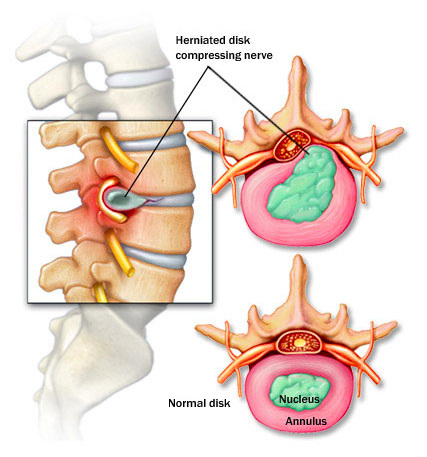Currently, millions of Americans suffer from chronic back pain and neck pain. Three out of ten Americans are suffering from low back pain at this very moment; eight out of ten Americans will experience low back pain in their lifetime! And whether this pain results from a severe injury or a mild lingering condition, this pain can be usually be traced to the spinal cord, the bony spinal column, and the nervous system.
Sources of Pain
The spinal cord consists of bones and spongey “buffer” regions known as discs. When there is misalignment or damage done to this “buffer,” this can cause instability in the spinal region triggering notable pain symptoms:
Herniated Disc (frequently a progression of a bulging or slipped disc)
Many can attribute chronic lower back pain (in the lumbar region) or neck pain (cervical spine) to a spinal disc that is unstable or ruptured. In many cases, this misalignment and damage results in a disc leak.
And this disc fluid leak can cause significant discomfort, especially if it is applying pressure to a nearby nerve. As an example, think of a jelly doughnut. If one were to move the doughnut side to side or front to back, that would be a “slipped” disc. Now, if one were to squash the doughnut and the jelly were to spurt out, that would be a “herniated disc.”
Pinched Nerve (aka sciatica)
When a leak of disc fluid causes a nearby nerve to become compressed (“squeezed”), it results in pain signals to the brain. This discomfort can also cause various symptoms ranging from severe pain to tingling, numbness, and weakness.

Diagnosis and Treatment
The first step to managing pain symptoms is to pay attention and not ignore them. The sooner one begins treatment, the better off one will be long-term. Meeting with a neurological specialist can help offer insight into the nature of the pain.
Your neurologist may perform a series of tests, including reflex tests and movement tests, as well as order an MRI, CT scan, or a discogram.
Electrodiagnostic testing may be very helpful in identifying exactly which nerve is inflamed and how severely. Once you have identified the location of the pain, there are several non-surgical and surgical intervention options available:
Non-Surgical Treatments such as physical therapy can be beneficial due to the focus on spinal support and building muscle strength. Physical therapy may include stretching, aerobics, and massage therapy. Of course, chiropractic care may also address the spinal issues, although from a slightly different approach.
These treatments can also be complemented with medications or steroid injections if needed.
Surgical intervention is needed when non-surgical treatment options have been exhausted, and the pain symptoms continue to interfere with daily life. To alleviate this pain, the disc causing the discomfort may need to be removed and replaced. In other cases, the patient may need to undergo a spinal fusion where the area between the spine is fused together to stimulate bone growth post-surgery. There are three main cases when it is appropriate to utilize spinal surgery; intractable pain, progressive weakness, and to avoid a neurological emergency (such as compression of the spinal cord or to prevent permanent loss of function).
Spinal Health: FAQs
1) Can a herniated disk eventually heal on its own?
A herniated disc can improve on its own through a reduction of inflammation; however, a herniated disc never “heals” completely
2) How do I know if I have a herniated disc?
The only way to know for sure is through an MRI scan. Not all herniated discs will cause symptoms (as some individuals will have experienced a fluid leak that does not interfere with the nerve root). For others, common symptoms such as pain in the lower back and neck can be signs of a possible disc injury.
3) Is spinal surgery invasive?
There is a degree of risk; however, spinal surgery is a minimally invasive surgery that involves a very clean removal of herniated disc material and does not interfere with surrounding organs.
4) How can I exercise if I am in so much pain?
I know for many, the thought of exercise when experiencing chronic pain is unimaginable. However, with a medical professional’s guidance and supervision, moderate spinal-friendly movements, such as stretching and flexibility activity (while avoiding any pounding type of activities), will alleviate long-term pain symptoms.
5) My neck hurts, and I haven’t experienced any injury
It doesn’t take much to misalign the spine. Whether it is extensive hours working at a desk, incorrect posture using your cell phone or iPad (“Tech Neck”), or poor spine posture in general, there are many causes of spinal dysfunction. If you are experiencing any form of pain that has not been resolved through over the countermeasures or personal efforts, it may be time to seek professional help.
A deconditioned spine from years of inactivity is highly susceptible to injury and pain. Alternatively, a strong and healthy spine can easily resist minor injury and trauma, leading to a pain-free existence. Never has the old adage been truer: an ounce of prevention is worth a pound of cure!
If you have any questions about spinal health or would like to schedule an appointment, please contact the Neurology Office for more help.
Feel free to share this with the people in your life who may benefit from this information! For more insights on neurology, check out our weekly tips on our Neurology Office Facebook page.
“To Cure Sometimes, To Heal Often, To Comfort Always”
Neurology Office, Joseph Kandel M.D. and Associates
“Concierge medicine without the concierge price”













